
INTRODUCTION
"Just across the water is Otterton, a quiet village of cob cottages, an ancient priory and an old mill. They still make Honiton Lace here."
S.V.B. Mais, `Glorious Devon', 1934
The purpose of a Village Design Statement is to manage change, whether that change is major new development or just cumulative, small-scale additions and alterations. It is not about whether development should take place; that is a job, in this instance, for the East Devon Local Plan. Rather, it is about how planned development should be carried out, so that it is in harmony with its setting and contributes to the conservation and enhancement of the local environment. Its purpose, therefore, is to complement the statutory planning process and to that end this Village Design Statement for Otterton has been adopted by East Devon District Council, from October 2004, as `Supplementary Planning Guidance'. This statement and the principles that it sets out emanate from the community. Following published guidance from the Countryside Agency a series of village appraisals were undertaken during the summer of 2003. The results were presented to the wider community through a consultative exhibition staged in December 2003, supported by a household questionnaire. It is the analysis of this questionnaire, (nearly a third of households responded) together with feedback from the exhibition and initial appraisals, which have shaped, and are referred to, in this document. Such views, often strongly held, have been tempered and underpinned by reference to a number of publications on the East Devon landscape and the village of Otterton, its environs and its heritage, the `East Devon Conservation Appraisals' and `Mark Rolle - his architectural legacy' to name but two (see bibliography). It should be stressed that this `Statement' does not seek to replace or repeat these exemplary works but rather to draw from them in establishing this guidance.
Background

England's countryside has been shaped by man's activities from the prehistoric times to the present day. The village of Otterton, and the countryside that frames it is no exception although, up to the middle of the last century, that change was gradual. Developing principally as a linear settlement its small farmsteads fronting on to a long central thoroughfare. Over time, these became interspersed with estate cottages, the whole commanded by the Church and former manor house, (itself built upon and from an earlier priory), reminders of former power and patronage.
Very much a case of evolution rather than revolution.
It was this historic value of the village that was recognised by the designation of a conservation area in 1972 and which was extended in 1993 to encompass some 55individually listed buildings. The wider landscape in which Otterton sits had already been recognised as nationally important through its designation as an Area of
Outstanding Natural Beauty (AONB) in 1963. Although still sitting relatively easily within the landscape, Otterton has witnessed substantial change in the last sixty years. Today, no working farm remains within the boundary of the village. Of the businesses that do remain, the mill (principally a craft centre and restaurant) and the pub (housing the village post office and shop) depend to a degree upon the many walkers and tourists drawn to the village by its character and setting. (A hairdresser and an engineering works complete the short list). Moreover, leave the older part of the village behind and the change is clearly evident. Development has taken place in clusters using designs that sit uneasily with what has gone before and the rural landscape that surrounds.